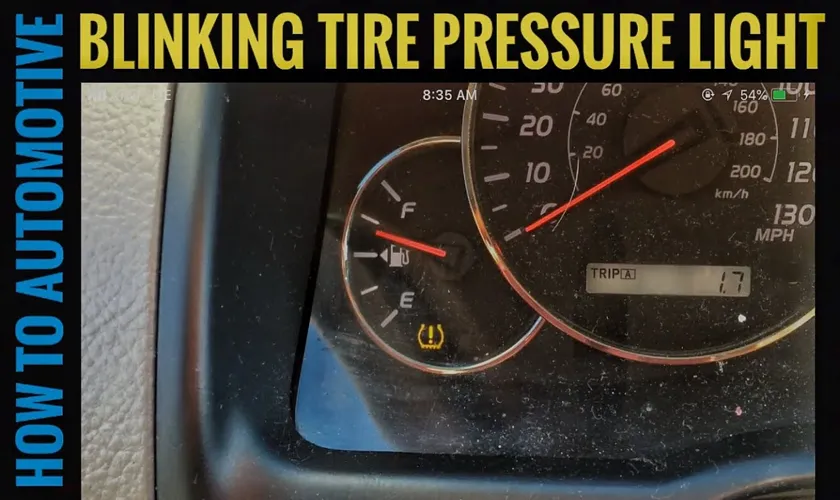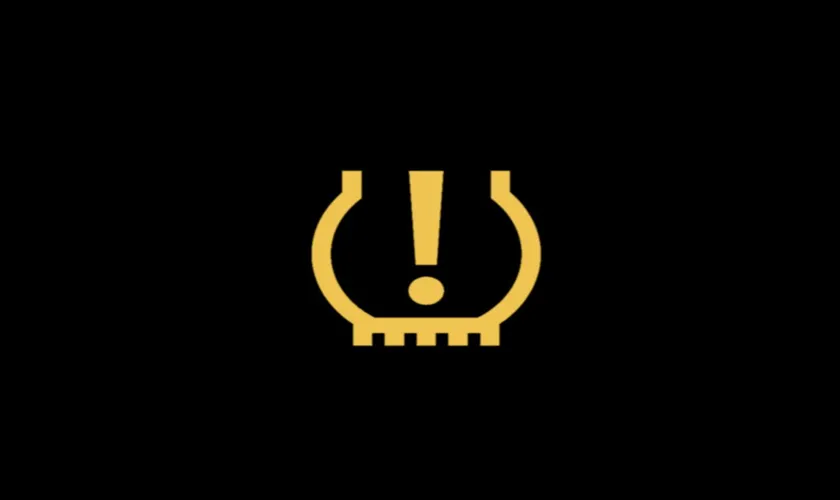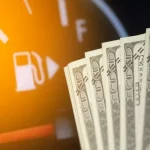Have you ever been driving and noticed a flashing tire pressure light on your dashboard? It can be a bit nerve-wracking to see, especially if you’re not sure what it means. But fear not! This helpful warning light can actually save you from bigger problems down the road. Ignoring it, however, can lead to costly repairs and even dangerous situations.
When your tire pressure light flashes, it means that your tire pressure is either too low or too high. This can cause your tires to wear unevenly, reduce gas mileage, and even damage your wheels. It’s important to address this issue as soon as possible to avoid potential accidents on the road.
But don’t fret! Fixing this problem is relatively easy. Take a quick trip to your local gas station or auto shop and have your tire pressure checked. If it’s too low, they can simply add air and you’ll be on your way.
If it’s too high, they can release some air to bring it back to the correct pressure. Remember, your tires are your vehicle’s only contact with the road and play a crucial role in your safety while driving. So next time you see that flashing tire pressure light, don’t ignore it! Take a few minutes to get it checked out and drive with confidence.
Table of Contents
Understanding Your Vehicle’s Tire Pressure Monitoring System
Have you ever been driving down the road and suddenly noticed that your tire pressure monitoring system (TPMS) light is flashing? This can be a bit unsettling and leave you wondering what the problem might be. Typically, when the TPMS light flashes, it means that there is a tire pressure issue that needs your attention. This could be caused by a number of factors such as a leak, puncture, or even just a change in weather.
A flashing TPMS light is not one to ignore, as low tire pressure can be dangerous and lead to decreased fuel efficiency and tire wear. If you notice this light flashing, make sure to check your tire pressure as soon as possible and address any issues that may be present.
What is a Tire Pressure Monitoring System?
A tire pressure monitoring system (TPMS) is a technology installed in modern vehicles that constantly monitors the air pressure in each tire. The system works by using sensors to track the pressure of each tire, and if it detects a drop in pressure below the recommended level, it will alert the driver through a warning light on the dashboard. The importance of TPMS can’t be overstated as it helps to prevent accidents by ensuring that your car always runs on optimal tire pressure.
Driving on under-inflated tires can lead to poor fuel economy, early tire wear and tear, and even a blowout on the road. Therefore, it’s essential to regularly check your tire pressure and ensure that your TPMS is correctly functioning. With a reliable TPMS, you don’t have to worry about tire pressure fluctuations and can focus on enjoying a smooth and safe driving experience.

How Does It Work?
Tire Pressure Monitoring System Have you ever wondered how your vehicle’s Tire Pressure Monitoring System (TPMS) works? It’s a relatively simple device that uses sensors placed inside each tire on your car to track the tire pressure. It detects and reports any fluctuations in tire pressure, whether too high or too low, to the vehicle’s computer. The information is then displayed on your dashboard, notifying you of any potential tire pressure issues.
The TPMS helps prevent accidents caused by overinflated or underinflated tires, and it’s mandatory in all new vehicles since 200 The TPMS helps you maintain your tires at the optimal pressure range and ensure that they wear evenly, which can prolong their lifespan. Don’t ignore your TPMS light or alerts and make sure to have your tires checked and properly inflated.
It will not only help you save money in fuel and tire replacement costs but also ensure a safe and comfortable driving experience.
Why Is It Important?
Understanding your vehicle’s tire pressure monitoring system is crucial for maintaining safe driving conditions and prolonging the life of your tires. The system’s purpose is to monitor your tire’s pressure levels and alert you when they fall below the recommended level. This information is essential because low tire pressure can lead to decreased gas mileage, tire damage, and accidents.
Additionally, understanding your tire pressure monitoring system can make it easier to identify and address issues with your tires, which can ultimately save you money on repairs and replacements. Think of it like a vital sign for your vehicle; just as you need to monitor your health to prevent illness, you must monitor your tire pressure to prevent issues with your car. By taking the time to understand your vehicle’s tire pressure monitoring system, you can ensure optimal safety and performance on the road.
The Significance of a Flashing Tire Pressure Light
If you are driving and notice that your tire pressure light is flashing, it is important to take heed. This typically means that your tire pressure is dangerously low and needs immediate attention. Driving on underinflated tires can lead to decreased fuel efficiency, decreased handling, and even tire failure.
When the tire pressure light flashes, it is best to pull over and check your tire pressure. If one or more tires are low, inflate them as soon as possible to ensure optimal safety and performance. Neglecting to address low tire pressure not only puts you at risk, but also endangers other drivers on the road.
So, the next time your tire pressure light flashes, remember to take action promptly to avoid any unfortunate and avoidable accidents.
Possible Causes of a Flashing Tire Pressure Light
A flashing tire pressure light can be a cause for concern, and it’s important to understand what it means and its significance. There could be several reasons why your tire pressure light is flashing, such as a sensor malfunction, low tire pressure, or even a puncture in your tire. It’s crucial to address the issue promptly, as driving on low tire pressure can lead to safety hazards like blowouts or uneven tread wear.
One reason you may see a flashing tire pressure light is due to a malfunctioning sensor. The sensor could be faulty, sending incorrect readings to your car’s computer system, causing the light to flash. Another cause may be low tire pressure, which could be due to changes in temperature, punctures, or even a slow leak.
In some cases, the tire pressure light may flash if there is a puncture or damage to the tire. Regardless of the cause, it’s best to take your vehicle to a professional mechanic to diagnose the issue and address it promptly. Maintaining proper tire pressure is crucial for a smooth, safe, and stable ride.
Neglecting to address a flashing tire pressure light can lead to complications, putting you and your passengers at risk. In summary, if you see a flashing tire pressure light, get it checked out immediately to avoid any potential safety hazards on the road.
What to Do When the Tire Pressure Light Flashes?
A flashing tire pressure light is an indicator that something is not quite right with your car’s tires. It could mean that there’s a puncture or leakage in one of your tires, or that the tire pressure is too low to sustain safe driving conditions. Whatever the case may be, it’s essential to address the issue promptly before it leads to more significant problems.
The best course of action is to pull over and check the tire pressure using a tire pressure gauge. If the pressure is low, fill up the tire to the recommended level. However, if you notice damage to the tire or suspect a puncture, it’s best to have it inspected and repaired by a professional.
Remember always to be vigilant of your tire pressure, as it impacts your vehicle’s overall safety, performance, and fuel economy. Taking care of your tires is taking care of your overall road safety.
Preventing a Flashing Tire Pressure Light
If you’ve ever experienced a flashing tire pressure light on your dashboard, you know how alarming it can be. This warning light indicates that the air pressure in one or more of your tires is too low, potentially leaving you at risk of a blowout or other safety hazards. To prevent the tire pressure light from flashing, it’s important to check your tires regularly and keep them properly inflated.
This means checking the air pressure every month and before long trips, as well as making sure to fill your tires to the recommended level listed in your vehicle’s manual. Another way to prevent a flashing tire pressure light is by investing in a tire pressure monitoring system (TPMS), which constantly monitors your tire pressure and alerts you when it becomes too low. Ultimately, taking regular care of your tires is key to staying safe on the road and avoiding any unexpected warning lights.
How to Maintain Proper Tire Pressure
Maintaining proper tire pressure is crucial to ensure your safety and the longevity of your tires. One common issue that many drivers face is the flashing tire pressure light on their dashboard. This can be caused by a variety of reasons, including low pressure, a malfunctioning sensor, or a punctured tire.
To prevent this from happening, it’s essential to check your tire pressure regularly and keep it at the recommended level, which can be found in your car’s manual or on the inside of the driver’s side door. You also want to make sure to inspect your tires for any signs of damage, such as cuts or bulges, and have them repaired or replaced immediately. By being proactive in maintaining proper tire pressure, you can avoid the inconvenience of a flashing light and ensure that your car drives smoothly and safely.
When to Check Tire Pressure
Tire Pressure, Flashing Tire Pressure Light Have you ever noticed the tire pressure light on your dashboard flashing intermittently? Ignoring it might be tempting, but it’s crucial not to overlook it. Checking your tire pressure regularly can prevent this unsettling light from turning on in the first place. So, how often should you check your tire pressure? A general recommendation is once a month, but this might vary depending on the type of vehicle and tire you have.
It’s also essential to check your tire pressure before embarking on a long driving journey and after extreme weather conditions. Unfortunately, leaving low tire pressure unchecked might lead to more extensive problems, affecting your car’s performance and even leading to tire blowouts. Preventing a flashing tire pressure light is crucial because it can help avoid unexpected car problems and save you time and money.
Remember to check your tire pressure regularly to keep your vehicle running smoothly and safely.
Conclusion
In conclusion, a flashing tire pressure light is like your car’s way of saying ‘Hey, did you forget about me?’ It’s a polite reminder that your tires may need a little TLC. So next time you see that pesky light flashing, give your tires some love and attention. Your car will thank you, and you’ll avoid any potential blowouts.
Remember, a little pressure can go a long way!”
FAQs
Why is my tire pressure light flashing?
Your tire pressure light is flashing to indicate that there is a problem with the pressure in one or more of your tires.
What does it mean when the tire pressure light is flashing?
A flashing tire pressure light means that there is a pressure-related problem with one or more of your tires.
How can I tell which tire is causing the flashing tire pressure light?
You can use a tire pressure gauge to check the pressure in each tire and see which one is low.
What should I do if the tire pressure light is flashing?
If the tire pressure light is flashing, you should check your tire pressure and inflate or replace any tires that are underinflated or damaged.
Can the tire pressure light flashing cause damage to my vehicle?
Driving on underinflated tires can cause damage to your vehicle’s suspension and steering components, and can also increase the risk of a blowout or accident.
How often should I check my tire pressure to avoid a flashing tire pressure light?
It is recommended to check your tire pressure at least once a month, or before long trips or heavy loads.
Is it safe to drive with a flashing tire pressure light?
It is not recommended to drive with a flashing tire pressure light, as it indicates a potentially dangerous problem with your vehicle’s tires. It is important to address the issue as soon as possible to ensure safety on the road.



